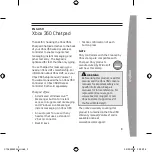
IOM-3381/4381
2
III. PRINCIPLE OF OPERATION
1. Movement occurs as pressure variations regis-
ter on the diaphragm. The registering pressure
is the outlet, P
2
, or downstream pressure. The
range spring opposes diaphragm movement. As
SECTION III
IV. STARTUP
SECTION IV
5. Slowly open the inlet (upstream) block valve ob-
serving the outlet (downstream) pressure gauge.
Determine if the regulator is flowing. If not, slowly
rotate the regulator adjusting screw clockwise
(CW) until flow begins.
6. Continue to slowly open the inlet (upstream) block
valve until fully open.
7. Continue to slowly open the outlet (downstream)
block valve, especially when the downstream pip-
ing system isn't pressurized. If the outlet (down-
stream) pressure exceeds the desired pressure,
close the block valve and go to Step 2, then return
to Step 4.
8. When flow is established steady enough that the
outlet (downstream) block valve is fully open, be-
gin to slowly close the bypass valve if installed.
9. Develop system flow to a level near its expected
normal rate, and reset the regulator set point by
turning the adjusting screw CW to increase outlet
pressure, or CCW to reduce outlet pressure.
10. Reduce system flow to a minimum level and
observe set point. Outlet pressure will rise from
the set point of Step 9. The maximum rise in
outlet pressure on decreasing flow should not
exceed the stated upper limit of the range spring
by greater than 10%; i.e. 20-80 psig (1.38-5.52
Barg) range spring. (Example: at low flow the
outlet pressure should not exceed 88 psig (6.07
barg), if it does, consult factory).
CAUTION
outlet pressure drops, the range spring pushes
the diaphragm down, opening the port; as outlet
pressure increases, the diaphragm pushes up
and the port opening closes.
2. A complete diaphragm failure will cause the regu-
lator to fail open.
10 A. Basic Regulator - (Refer to Figure 1, Model 3381
or 4381): Regulator may be rotated around the
pipe axis 360°. Recommended position is with
spring chamber vertical upwards. Orient such
that the spring chamber vent hole does not col-
lect rainwater.
10B. Cryogenic Regulator - Options 3381-5 and 4381-
36 (Refer to Figure 2, Model 3381 or 4381):
a. Recommended installation is with spring
chamber hanging directly below the body
in a vertical downwards orientation. Allows
water to drain; etc.
b. Recommend inert purge gas be supplied to
spring chamber through vent hole and be
discharged out drain hole.
11. Regulators are not to be buried underground.
12. For insulated piping systems, recommendation is
to not insulate regulator.
CAUTION
The maximum outlet pressure is listed on the nameplate
as the upper range spring pressure level, and is the recom-
mended "upper operative limit" for the sensing diaphragm
(See Section IV. Startup, Step 7). Higher press ures could
damage the diaphragm. (Field hydrostatic tests frequently
destroy diaphragms. DO NOT HYDRO STATIC TEST THRU
AN INSTALLED UNIT; ISOLATE FROM TEST.)
1. Start with the block valves closed. A bypass
valve may be used to maintain outlet pressure
in the downstream system without changing the
following steps.
2. Relax the range spring by turning the adjusting
screw counter clockwise (CCW) a minimum of
three (3) full revolutions. This reduces the outlet
(downstream) pressure set point.
3. If it is a “hot” piping system, and equipped with
a bypass valve, slowly open the bypass valve
to preheat the system piping and to allow slow
ex pan sion of the piping. Ensure proper steam
trap operation if installed. Closely monitor outlet
(downstream) pressure via gauge to ensure not
over-pressurizing.
NOTE:
If no bypass valve is
installed, extra caution should be used in starting
up a cold system; i.e. do everything slowly.
4. Crack open the outlet (downstream) block valve.


























